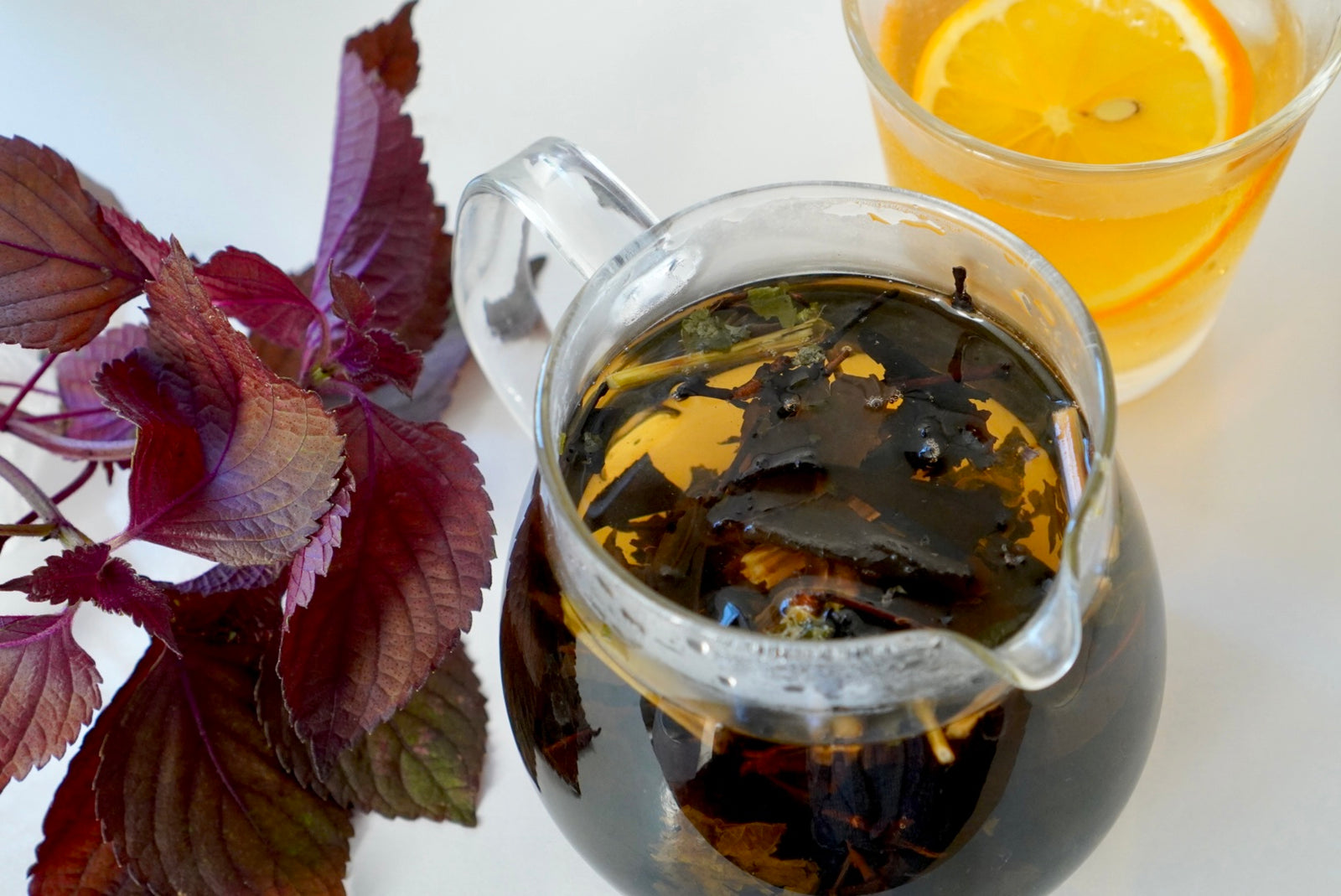今回ご紹介したいのは、出雲番茶と赤紫蘇をブレンドした、ちょっと変わったブレンドティーです。
出雲番茶
出雲は島根県にある地名で、出雲神話と日本でも有数の神社である出雲大社で知られています。出雲番茶は文字通り出雲地方のお茶を意味します。赤ちゃん番茶とも呼ばれ、出雲地方では赤ちゃんからお年寄りまで幅広く愛されています。
夏の太陽を浴びた秋に収穫された、茎の太い茶葉から作られるお茶です。ほうじ茶と同じような製法で作られます。ただし、緑茶やほうじ茶を作る際に蒸しあがった後に揉むのに対し、ほうじ茶は揉みません。淹れると、揉まれていない茶葉が見えるのが印象的で、出雲の自然を感じます。
赤紫蘇
赤紫蘇(あかじそ)は、シソ科の植物で、西洋では赤紫蘇、紫蘇、シソとも呼ばれ、日本人の生活に欠かせないハーブです。豊富な栄養と優れた効能を持ち、古くから日本の食卓を支えてきました。
赤紫蘇についてはこちらから > 赤紫蘇(シソ)とは何か、そしてどのように楽しむか

味はいかがですか?
出雲番茶は、春摘みの緑茶に比べてまろやかで優しい味わいです。秋摘みの濃い茶葉は、春の新芽よりもカフェイン含有量が少ないからです。さらに、焙煎することでカフェイン含有量も減少します。そのため、赤ちゃんにも安心して飲めるお茶として人気です。お子様からご年配の方まで安心してお召し上がりいただけ、夜遅くまでお楽しみいただけます。焙煎することで、豊かな香りとナッツのような風味、そしてほのかなスモーキーな味わいが加わります。
赤紫蘇は、鮮やかな辛さと酸味の複雑な風味とミント系の爽やかな香りを持つ、軽い味わいです。
赤紫蘇の風味が出雲番茶とマッチして、気分をリフレッシュさせてくれます。

淹れ方
ティーポットに熱湯を注ぎ、2~3分間蒸らします。
熱湯400mlに対して茶葉5gを使用します。
楽しみ方
食後
出雲番茶は食後に飲むことが多く、脂っこい料理の後などにさっぱりとした味わいを楽しめます。また、赤紫蘇は胃腸の調子を整える効果もあるので、食後に飲むのにぴったりのブレンドティーです。
おやつと一緒に
このお茶の風味は、チーズ、プルーン、レーズンとよく合います。軽食と一緒にゆったりとくつろぐのにぴったりです。
茶漬け用
お茶漬けには、ネギ、セリ、シソなどの香味野菜が添えられることが多いですが、このお茶を使えば、香味野菜を加えなくても、風味豊かなお茶漬けをお楽しみいただけます。
茶漬けのレシピはこちらから茶漬けレシピ

アイスティー
アイスティーとして飲むのもおすすめです。風味が引き立ち、より爽やかな味わいになります。このブレンドティーは、一般的な緑茶、紅茶、コーヒーよりもカフェインが少ないので、冷たいものをたっぷり飲みたい方にもおすすめです。レモンのスライスを添えると、見た目も華やかになり、夏らしさもアップします。
上の写真の熱いお茶と同じように淹れて、冷ましてからお召し上がりください。
今日のおすすめ
この記事のお茶
赤紫蘇ハーブティー
塩漬け赤紫蘇パウダー
飯島清太郎商店 KN004: ゆかり - 天日干し大葉塩漬け ゆかり


